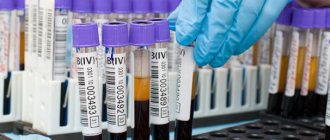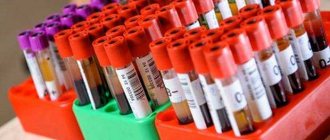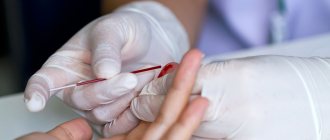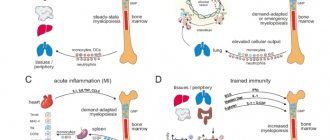November 14, 2018
All tests in 1 day
One type of laboratory diagnosis is a general blood test. It allows you to identify a large number of pathologies, such as malignant tumors, infectious, inflammatory diseases, etc. It can also be used to evaluate the effectiveness of patient treatment. After all, a general blood test can tell a lot about the state of the body.
Only specialized doctors can correctly decipher a general blood test. Therefore, without the appropriate medical knowledge, you should not even try to do it yourself. But it will not be superfluous to know by what indicators the blood is analyzed, as well as the norms of the test result. You will find this information in our article.
Table 1
| Index | Designation | In men | Among women |
| Red blood cells (x 1012/l) | R.B.C. | 4-5,1 | 3,7-4,7 |
| Average erythrocyte volume (fl or µm3) | MCV | 80-94 | 81-99 |
| Erythrocyte sedimentation rate (mm/h) | ESR | 2-15 | 2-10 |
| Anisocytosis of erythrocytes (%) | RDW | 11,5-14,5 | 11,5-14,5 |
| Hemoglobin (g/l) | HGB | 130-160 | 120-140 |
| Average hemoglobin level in erythrocyte (pg) | MCH | 27-31 | 27-31 |
| Average erythrocyte hemoglobin concentration (%) | MCHC | 33-37 | 33-37 |
| Color index | CPU | 0,9-1,1 | 0,9-1,1 |
| Hematocrit (%) | HCT | 40-48 | 36-42 |
| Platelets (x 109/l) | PLT | 180-320 | 180-320 |
| Average platelet volume (fl or µm3) | MPV | 7-11 | 7-11 |
| Reticulocytes (%) | RET | 0,5-1,2 | 0,5-1,2 |
| Leukocytes (x 109/l) | WBC | 4-9 | 4-9 |
Analysis transcript
All standard ESR indicators are available in a special table, where they are indicated in accordance with gender and age. In this case, only a doctor should interpret the answer received, since the result of the study can vary in any direction depending on physiological or pathological processes. To assess the situation, the specialist will take into account a whole range of related factors. At the same time, you need to know that in 5% of the world's inhabitants, the analysis shows a high ESR for no apparent reason.
| Age | Norm, mm/h |
| up to 13 years old | 4-12 mm/h |
| 13-18 years old | 3-18 mm/h |
| 18-30 years old | 2-15 mm/h |
| 30-40 years | 2-20 mm/h |
| 40-50 years | 0-26 mm/h |
| 50-60 years | 0-26 mm/h |
| after 60 years | 2-55 mm/h |
| During pregnancy | up to 45 mm/h |
table 2
| Index | x 109/l | % |
| Band neutrophils | 0,04-0,3 | 1-6 |
| Segmented neutrophils | 2-5,5 | 45-72 |
| Basophils | up to 0.065 | up to 1 |
| Eosinophils | 0,02-0,3 | 0,5-5 |
| Lymphocytes | 1,2-3 | 19-37 |
| Monocytes | 0,09-0,6 | 3-11 |
The results of a general blood test (Table 1) show many indicators. Let's consider the main ones:
- RBC – total number of red blood cells (erythrocytes). The pathological increase in these cells is associated with impaired hematopoiesis. A decrease in red blood cells is usually a consequence of anemia, hemolysis and blood loss.
- HGB stands for hemoglobin, which is a protein containing iron. It transports oxygen to tissues, and carbon dioxide from them, and also maintains acid-base balance. A decrease in hemoglobin most often occurs due to anemia.
- HCT – hematocrit. It is defined as the ratio between the red blood cells that have settled to the bottom after taking the test and the total blood volume. An increase in this indicator indicates polyuria, erythrocytosis or erythremia. A decrease in hematocrit level occurs with anemia and an increase in circulating blood volume.
- PLT – platelets. These cells are responsible for blood clotting. If their number decreases, then the cause may be viral diseases, bone marrow lesions, bacterial infections and other pathologies. An increase in the number of platelets is caused by a wide variety of ailments: from joint diseases to cancer.
- CPU – color indicator. It determines the saturation of red blood cells with hemoglobin. If it is insufficient, this may indicate iron deficiency anemia, anemia or lead poisoning. When CP rises above normal, the cause is oncology, gastric polyposis and deficiency of vitamins B9 and B12.
- Erythrocyte indices: MCV - average volume of erythrocytes, used to determine water-salt balance and type of anemia;
- RDW is the degree of red blood cell diversity, which determines how different cells differ from each other in volume;
- MCH – average hemoglobin content in erythrocyte; this criterion is considered analogous to the color indicator;
- MCHC – average concentration and content of hemoglobin in red blood cells; this indicator is calculated taking into account the level of hematocrit and hemoglobin.
Now let's move on to the leukocyte formula (Table 2). It determines the percentage of different types of white blood cells in the blood, that is, the relative content of each type of white cell. What is this formula for? It is very important because with any changes in the body, the percentage of certain types of white cells in the blood decreases or increases. This is associated with a decrease or increase in other types. Based on the information obtained from the leukocyte formula, one can judge the course of a particular pathology, the occurrence of complications, and also more accurately predict the outcome of the disease.
How to prepare for a blood test for ESR?
In order for the result of the procedure to be as reliable as possible, you need to prepare for it. It is a well-known fact that you need to donate blood on an empty stomach - and this is usually not forgotten. However, this is not the only recommendation. You also need:
- Temporarily, for 1-2 days before taking the test, give up alcohol;
- Refrain from fatty and spicy foods the day before;
- Do not smoke at least 2-3 hours before the procedure;
- Avoid physical activity immediately before blood collection.
You should also tell your doctor about the medications you are taking. Some medications can affect test results.
Symptoms of an increased rate
Symptoms indicating increased ROE:
- inflammatory processes accompanied by pain;
- dental pain;
- acute pain in the abdomen;
- heartache;
- pain in the joints and spine.
With a low ESR, the following conditions are observed:
- dizziness;
- nausea;
- weakness;
- yellowing of the skin and whites of the eyes.
A reduced ROE in the body can also be a signal of dangerous pathologies.
When is it appointed?
A general (biochemical) blood test with ESR measurement is prescribed in several cases:
- during a preventive examination, as a method of determining the degree of health of the body;
- for the diagnosis of diseases accompanied by inflammatory processes (infections, tumors, etc.), erythermia, acidosis, etc.
The determination of ESR is fundamental for identifying pathological processes in the body during the diagnosis of infectious diseases of the respiratory tract, namely:
- sinusitis, sinusitis;
- angina;
- inflammation of the pharynx, larynx and trachea;
- bronchitis;
- pneumonia;
- ARVI;
- flu.
After drug treatment of these diseases, a control clinical blood test for ESR is performed, which returns to normal within 7-10 days after recovery.
Why is ESR elevated in men?
The main reasons for increasing the ESR level:
- Joint damage;
- Diabetes;
- Liver damage;
- Pyelonephritis and other diseases of the genitourinary system;
- ARVI, influenza;
- Heart diseases;
- Malignant tumors.
Attention! You should never focus on the value of one indicator. If ESR is elevated, a man is always referred for a comprehensive examination.
The analysis will also show an excess in case of exacerbation of allergies, for example, to food or medicines, household chemicals.
To improve your appearance
Support for Turbo pages on a wider class of mobile screens - so that your Turbo pages look equally good not only on mobile, but also on tablets.
Transferring html layout directly to RSS. To make it more convenient for you to work with the appearance of Turbo pages, we will add the ability to transfer your own html layout directly to RSS. It will be possible to transfer ready-made blocks of your website to the Turbo page practically without changes and not waste time re-configuring the appearance.
Settings for basic design elements without CSS. And so that you can save time on developing your own CSS, let's add the following features:
- customize color, font, logo and other elements directly in Webmaster,
- quickly enable light and dark themes on your website.
Fictitious increase in indicators
An increase in the ROE coefficient beyond the limits based on age and gender does not always indicate the presence of pathology in the patient’s body. There are cases when elevated numbers are false indicators of illness. The following factors can provoke this result:
- the patient has varying degrees of obesity, unhealthy diet;
- elevated cholesterol levels, which can cause an increase in ESR;
- the patient is taking vitamin complexes or drugs of a medicinal group with a high content of vitamin A, as well as using oral contraceptives;
- recent vaccination against hepatitis;
- features of the female body;
- the presence of regular depressive and stressful overstrains.
The task of the attending doctor in such a situation is to correctly interpret the test results, and if there are doubts about the reliability of the data, send the person for re-analysis and prescribe auxiliary studies.
- ESR for arthrosis - All about joints
Development plan
- Support for multimedia content (illustrations, videos)
- Support for third party ad networks via ADFOX
- Support for third-party analytics counters (Google Analytics, Mail.Ru, Rambler Top 100, Mediascope)
- Speed up loading Turbo pages by 4 times
- Tables, lists, quotes
- Image and photo galleries
- Displaying comments
- Embed codes for content from YouTube, Vimeo, Instagram, Twitter
- “Endless” feed (block “You may be interested in”)
- Site navigation
- Share button
- Additional advertising spaces
- Advanced analytics capabilities
- Ad rendering speed
- API for publishing content
- Call button, chats and feedback forms
- Support for content embed codes from VKontakte and Odnoklassniki
- Design customization in CSS
- Supports GIF animation and video players
- Editor for debugging Turbo pages
- Rating block
- Media content gallery with slider
- Quickly view a larger image by clicking
- Content block and anchor links
- Sidebar – new menu block
- Additional design types for the “You may be interested in” block
- Support for embedded content from Yandex.Maps and Yandex.Music
- Search form - on your website or with sending a request to search engines
- Impressions of new pages in Turbo format when following links from Turbo pages
- Product cards for online stores
- More statistics in Metrica and the ability to use goals
- Video in Turbo
- New page types
- Poll block
- Advertising optimization - new formats
- The ability to place a product on Turbo pages in one click so that the user does not leave the accelerated version of the store
- Custom blocks
- Authorization
- Possibility to leave a comment
- Advanced features of Metrica
- Feedback from webmasters
Expanded appearance customization options
We have started testing the display of elements created by site owners.
For example, Turbo pages can have complex interactive components using JavaScript, such as diagrams of the placement of chess pieces or players on the field. But there should be more tools that allow you to flexibly customize Turbo pages - and we, of course, will continue to add them. Please tell us what kind of customization is required for the Turbo pages of your website - leave your contacts in this form, and a specialist from the development team will contact you to clarify the details.New opportunities for online stores
Online payment and shopping cart will appear in the e-commerce arsenal. Moreover, in the Turbo version of the store you will be able to make purchases directly from the list of products, and after going to the cart, select delivery options. We will add the ability to pre-fill fields (for example, name or contacts) to the order form - if the site visitor is authorized in his Yandex account. It will become more convenient and easier for users to interact with the Turbo version of the store - there will be fewer failures and more conversions.
Advanced analytics in Yandex.Metrica
The Metrics Webvisor tool will help you analyze in detail the behavior of visitors to Turbo pages.
It records the actions of visitors on the site and shows them in video format - this way you can identify problems in navigation, logic and usability, and as a result, increase site conversion. Metrica will also feature new reports to analyze the effectiveness of the Turbo version of online stores.New blocks and widgets on Turbo pages
By the end of the year, Turbo pages will have:
a multi-level menu,- customizable dynamic forms,
- Apester platform embeds for surveys and quizzes,
- cards for grouping content on a page,
- possibility of fixing the site header,
- Scrolling support when viewing an image gallery,
- “Expand” button to view articles on the desktop,
- “breadcrumbs” to facilitate navigation on the site,
- opportunity to comment on articles.
And new widgets - including Market and Zen widgets
- will increase traffic and expand the site’s audience.
New advertising formats and optimization opportunities
- will appear with a parallax effect
, which will be placed under the site content. The content of such an ad unit appears from underneath the content as the user scrolls the page. The advertisement begins to appear smoothly from the bottom of the banner, and when scrolling, it gradually opens, after which it is just as smoothly and neatly hidden under the content.
Fixed horizontal sticky blocks.
for Turbo pages. This is a new tool for A/B testing of advertising designs with automatic selection of the most profitable option for each site visitor, which is currently undergoing closed beta testing. It will allow you to choose the optimal design of contextual advertising for a specific site.
on Turbo pages, we optimize advertising placements and other parameters so that auto placement brings you more income.
General information about the study
Determination of erythrocyte sedimentation rate (ESR) is an indirect method for identifying inflammatory, autoimmune or oncological diseases. It is performed on a sample of venous or capillary blood, to which a substance has been added that allows it not to clot (anticoagulant). When researching using the Panchenkov method, blood is placed in a thin glass or plastic tube and monitored for an hour. At this time, erythrocytes (red blood cells), as having a large specific gravity, settle, leaving a column of transparent plasma above them.
The ESR is calculated based on the distance from the upper boundary of the plasma to the red blood cells. Normally, red blood cells settle slowly, leaving very little pure plasma. For this method, a Panchenkov apparatus is used, consisting of a tripod and capillary pipettes with a 100 mm scale.
For capillary photometry (automatic analyzers ROLLER, TEST1), the kinetic “stopped jet” method is used. At the beginning of the analysis, programmed mixing of the sample occurs in order to disaggregate the red blood cells. Ineffective disaggregation or the presence of microclots can affect the final result, since the analyzer actually measures the kinetics of red blood cell aggregation. In this case, the measurement occurs in the range from 2 to 120 mm/h. The results of measuring ESR by this method have a high correlation with the Westergren method, which is the reference for determining ESR, and have identical reference values.
The results obtained using the capillary photometry method in the region of normal values coincide with the results obtained when determining ESR using the Panchenkov method. However, the capillary photometry method is more sensitive to an increase in ESR, and the results in the zone of increased values are higher than the results obtained by the Panchenkov method.
An increase in the level of pathological proteins found in the liquid part of the blood, as well as some other proteins (the so-called acute-phase proteins that appear during inflammation) contributes to the “gluing” of red blood cells. Because of this, they settle faster and the ESR increases. It turns out that any acute or chronic inflammation can lead to an increase in ESR.
The fewer red blood cells, the faster they settle, which is why women have a higher ESR than men.
Indications for research
A referral for ESR analysis is most often prescribed by a general practitioner. The analysis is carried out after acute viral and bacterial diseases to exclude the presence of complications.
Subspecialists can prescribe a referral for analysis:
- rheumatologist for joint pain; temperature, increased fatigue;
- surgeon for abscesses, suppuration, abdominal pain;
- nephrologist for problems with the urinary system;
- gynecologist for pain, pathological discharge;
- gastroenterologist for pain in the abdominal cavity, heaviness in the right hypochondrium, yellowing of the skin;
- endocrinologist for specific symptoms indicating metabolic disorders in the body;
- hematologist for a comprehensive examination of the hematopoietic process.
A referral for ESR testing is issued during planned hospitalization and surgical interventions. ESR is part of express tests during emergency operations.









